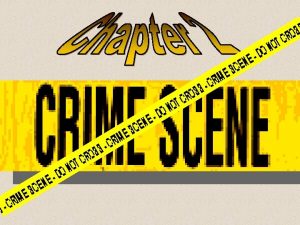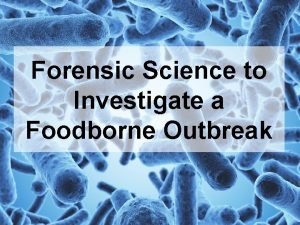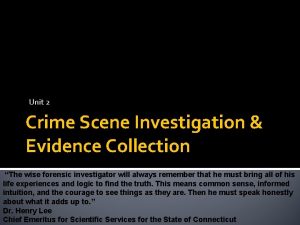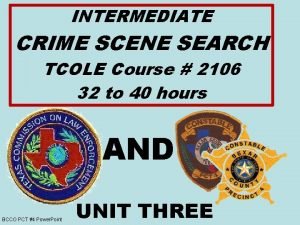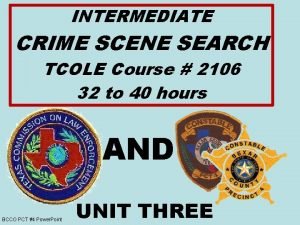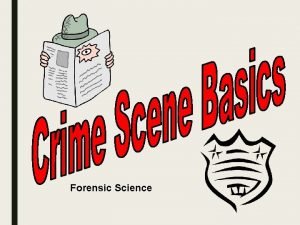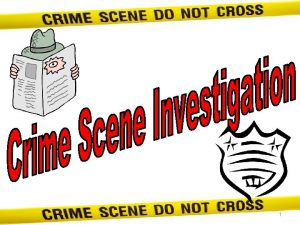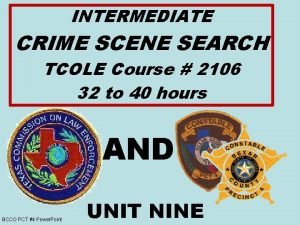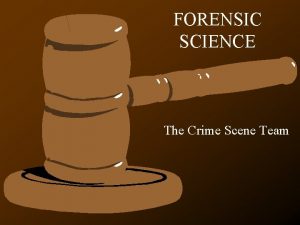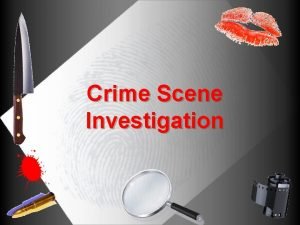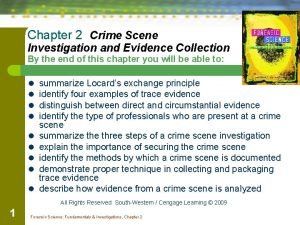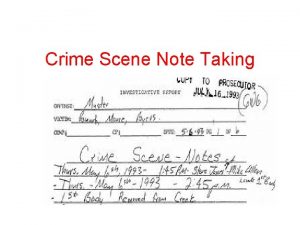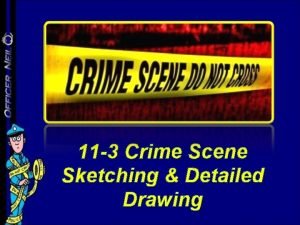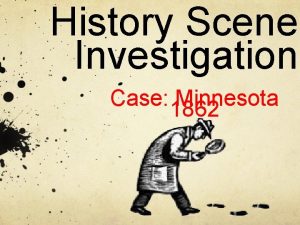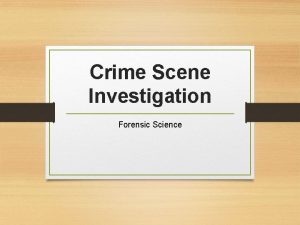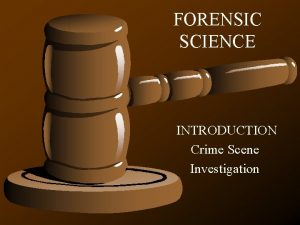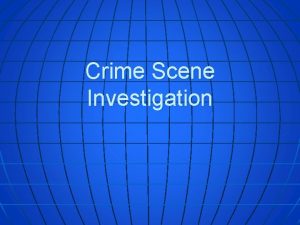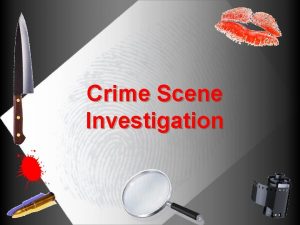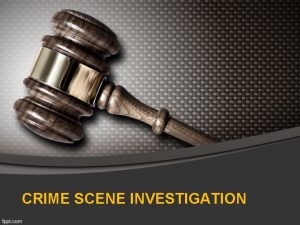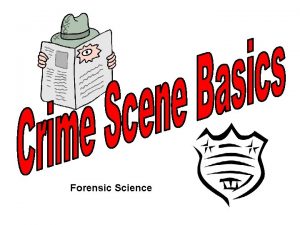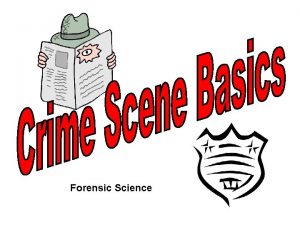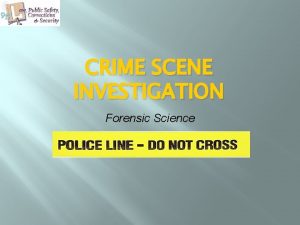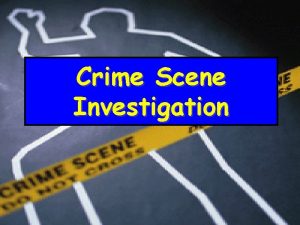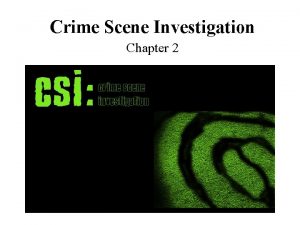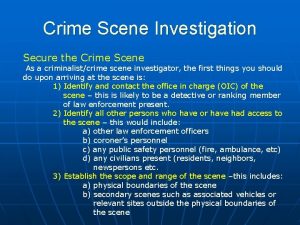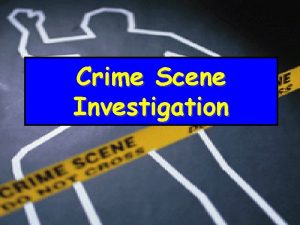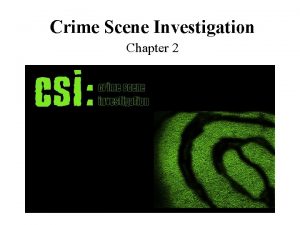Forensic Science The Crime Scene Crime Scene Investigation



















- Slides: 19

Forensic Science The Crime Scene

Crime Scene Investigation n Purpose: to help establish what happened (crime scene reconstruction) and to identify the responsible person. Investigators must: ¨ carefully document the conditions at a crime scene ¨ Recognize and collect all relevant physical evidence ¨ Determine the full extent of a crime scene. The law enforcement officer who protects and searches a crime scene plays a critical role in determining which pieces of physical evidence will be used in solving or prosecuting violent crimes.


The Crime Scene n n A place where a crime has taken place. A starting point for a criminal investigation. There is no "crime scene exception" to the Fourth Amendment (illegal search and seizure) If the scene is a protected area such as a house or private part of a business, then a search warrant or consent must be obtained.

Processing the Crime Scene There are 7 steps to processing a crime scene 1. 2. 3. 4. 5. 6. 7. Secure and Isolate the Crime Scene Record the Scene Photograph, Sketch, Take Notes Conduct a Systematic Search For Evidence Collect and Package Evidence Maintain Chain of Custody Obtain Controls Submit Evidence to the Laboratory

Law Enforcement Personnel on the scene n n n In order for physical evidence to be analyzed and to tell its part of the story, it must first be properly collected. In order for the proper collection to take place, the crime scene, must be properly secured, protected, and preserved. This scene security, protection, and preservation is the responsibility of any and all law enforcement personnel who come in contact with the scene, the suspect, and/or the victim.

Crime Scene Investigation Team Leader n Photographer and Photographic Log Recorder n Sketch Preparer n Evidence Recorder/Evidence Recovery Personnel n Specialists n

Crime Scene Search Patterns n n n To locate, identify, and collect any tangible material which may be associated with a suspect and/or victim Standard search patterns: spiral, grid, strip or line, and quadrant or zone search Important things to do during a search: Search from the general to the specific for evidence. ¨ Be alert for all evidence. ¨ Search entrances and exits. ¨ Discuss the search with all personnel. ¨

Recording the Crime Scene n n n Includes transient details such as lighting (on/off), drapes (open/closed), weather, or furniture moved by medical teams. The scope extends to possible arguments which might be made in this case (suicide/self defense) and documenting conditions supporting or refuting these arguments. Important to recognize what should be present at a scene but is not (victim's vehicle/wallet) and objects which appear to be out of place (ski mask) and might have been left by the assailant.

Photographer/Photographic Recorder 1. 2. 3. 4. 5. 6. Photograph entire area before it is entered. Photograph victims, crowd, and vehicles. Photograph entire scene with overall, medium and close-up coverage, using measurement scale when appropriate. Photograph major evidence items before they are moved Photograph all latent fingerprints and other impression evidence before lifting and casting are accomplished. Prepare photographic log and sketch.

Photographing the Crime Scene n Film is cheap; you can never take too many pictures. Utilize a flash if necessary. n Move evidence for better photographs only after the "as is" photograph has been taken and is necessary for additional identification.

Sketch Preparer 1. 2. 3. 4. 5. Diagram immediate area of scene and orient diagram with sketch. Show major items of evidence on sketch. Designate and label areas to be searched and advise team leader and all other search members of designated search areas. Obtain assistance for taking measurements and double check measurements. Ensure necessary administrative information, such as scale disclaimer (not drawn to scale), is recorded on sketch.

Sketching the Crime Scene n Documentation of physical evidence locations, as well as measurements showing pertinent size and distance relationships in the crime scene area.

Evidence Collector/Custodian 1. 2. 3. 4. 5. 6. Have significant evidence photographed before collection. Describe evidence and its location on appropriate bag or envelope. Sign and date evidence container/maintain chain of custody. Appropriately collect and package evidence to maximize evidence integrity. Maintain evidence log. Use appropriate protective equipment (gloves) and methods when dealing with potentially infective evidence (blood).

Collecting Physical Evidence n n n Any collected evidence should have its location and condition documented before it is removed Evidence should be collected in appropriate containers, wearing gloves Containers/envelopes should be sealed with tamper-proof tape Seals should be signed Chain of Custody must be maintained

Information On Evidence Packaging n 1. 2. 3. 4. 5. The following information should be included on evidence packaging: Location of crime scene Location of evidence at scene and time of collection Personnel who collected the evidence Condition of item at time of collection Chain of Custody log

Specialists The field of forensic science is so broad today that no agency will have every form of specialty service available from among its ranks. n Typically, specialists are brought in from industry, the academic community, private scientific laboratories, and similar concerns. n Some items to consider when dealing with outside specialists: 1. The competence and reliability of the specialist. 2. The ability of the specialist to work at a scene within law enforcement guidelines. 3. The role of the specialist in presenting expert testimony in court.

Obtaining Controls from the Crime Scene n n Controls are physical evidence whose origins are known, such as carpet fibers from a suspects home, that can be compared to crime scene evidence. The crime lab must have a thorough sample of control materials for comparison.

Submitting Evidence to the Crime Lab n n Evidence can be submitted to the crime laboratory by a crime scene investigator personally or via the mail Chain of Custody must be maintained at all times Many labs require specific documentation before they will process evidence Evidence evaluated by the lab may take a long time to process, or be held due to back log.
 Forensic science begins at the crime scene
Forensic science begins at the crime scene Forensic science foodborne outbreak investigation answers
Forensic science foodborne outbreak investigation answers Seven s's of crime scene investigation description
Seven s's of crime scene investigation description Tcole crime scene investigation
Tcole crime scene investigation Intermediate crime scene investigation #2106
Intermediate crime scene investigation #2106 Crime scene investigation vocabulary
Crime scene investigation vocabulary Vocabulary crime scene
Vocabulary crime scene Tcole 2106
Tcole 2106 Rough sketch vs final sketch crime scene
Rough sketch vs final sketch crime scene Crime scene investigation background
Crime scene investigation background Small amounts of trace evidence can be conveniently
Small amounts of trace evidence can be conveniently Chapter 2 crime scene investigation and evidence collection
Chapter 2 crime scene investigation and evidence collection Datum point forensics
Datum point forensics Intermediate crime scene investigation texas
Intermediate crime scene investigation texas Note taking crime scene investigation
Note taking crime scene investigation The seven s's of crime scene investigation
The seven s's of crime scene investigation Disadvantages of freehand drawing
Disadvantages of freehand drawing Forensic pathologist vs forensic anthropologist
Forensic pathologist vs forensic anthropologist Who is this
Who is this Historical scene investigation
Historical scene investigation
